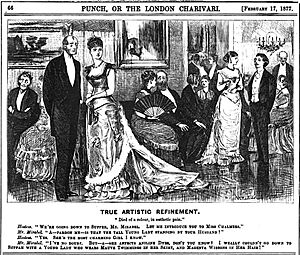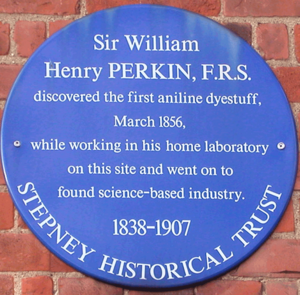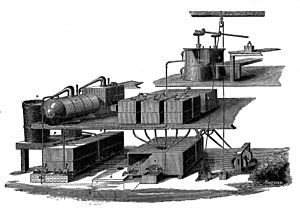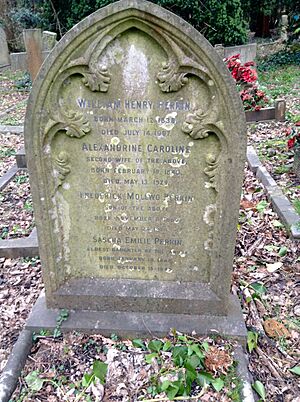William Henry Perkin facts for kids
Quick facts for kids
Sir William Henry Perkin
|
|
|---|---|

William Perkin (1838–1907)
|
|
| Born | 12 March 1838 London, England
|
| Died | 14 July 1907 (aged 69) London, England
|
| Alma mater | Royal College of Chemistry |
| Known for | Aniline dye Perkin's mauve Perkin reaction |
| Awards |
|
| Scientific career | |
| Fields | Chemistry |
| Influences | August Wilhelm von Hofmann |
| Signature | |
Sir William Henry Perkin (1838–1907) was a British chemist and businessman. He is famous for accidentally discovering the first man-made (synthetic) organic dye. This dye, called mauveine, was made from a chemical called aniline.
Perkin made this amazing discovery when he was only 18 years old! He had been trying to create a medicine for malaria called quinine. Even though he didn't succeed with quinine, his discovery of the dye changed the world of dyes and fashion forever. He even built a factory to make his new dye.
Contents
Early Life
William Perkin was born in London, England, on March 12, 1838. He was the youngest of seven children. His father, George Perkin, was a successful carpenter.
When William was 14, he went to the City of London School. There, his teacher, Thomas Hall, noticed his talent for science. Hall encouraged him to study chemistry.
An Amazing Accident
In 1853, at age 15, Perkin started studying at the Royal College of Chemistry. His teacher was August Wilhelm von Hofmann. At that time, chemistry was still quite new. Scientists knew about many elements, but it was hard to figure out how they were arranged in different compounds.
Hofmann thought it might be possible to create quinine in a lab. Quinine was a very expensive natural substance used to treat malaria. Perkin became one of Hofmann's assistants and started experiments to try and make quinine.
The Discovery of Mauveine
During a holiday in 1856, Perkin did some extra experiments in a small lab at his home. It was there that he made his big accidental discovery. He found that aniline could be changed into a purple substance. When he cleaned this substance with alcohol, it made a very strong purple color.
Perkin loved painting and photography, so he was very excited about this purple color. He did more tests with his friend Arthur Church and his brother Thomas. They kept their experiments secret from Hofmann because it wasn't part of their quinine work. They worked in a small hut in Perkin's garden.
They soon realized they could make a lot of this purple substance. They thought it could be sold as a dye, which they named mauveine. Their first tests showed that it dyed silk very well. The color also stayed bright after washing and being in the light.
They sent samples to a dye factory in Scotland. The manager, Robert Pullar, sent back a very positive reply. Perkin applied for a patent for his discovery in August 1856. He was still only 18 years old!
Why Mauveine Was So Important
Before Perkin's discovery, all dyes came from natural sources. Many of these natural dyes were expensive and hard to get. Also, many of them faded easily. The color purple was especially rare and costly. It had been a sign of royalty and importance since ancient times.
Perkin and his brother realized they had found a way to make a purple dye that was much cheaper and easier to produce. This meant it could be a huge success!
Perkin's discovery happened at the perfect time and place. England was in the middle of the Industrial Revolution, which was greatly helped by new ways to make textiles (cloth). Also, the science of chemistry had grown enough to help industrial processes. The main ingredient for his dye, coal tar, was easily available. It was a leftover product from making coal gas and coke.
After inventing the dye, Perkin still had to solve many problems. He needed money to produce it, find ways to make it cheaply, and figure out how to dye cotton with it. He also had to convince dye companies to use it and make people want to buy clothes dyed with it.
Perkin worked hard on all these things. He convinced his father to invest money. He worked with his brothers to build a factory. He even invented a special chemical (a mordant) to help dye cotton. He also gave advice to dye companies and told everyone about his new dye.
The demand for mauveine grew even more when Queen Victoria in Britain and Empress Eugénie in France started wearing similar colors. Also, the crinoline (a large, hooped skirt) became popular. These skirts used a lot of cloth, which meant more dye was needed.
Perkin's mauve was cheaper than old purple dyes and became incredibly popular. People even joked about "mauve measles" because so many people wore the color. Everything worked out for Perkin, and he became very rich. After mauveine, many new aniline dyes were discovered, and factories making them appeared all over Europe.
Later Work
William Perkin continued to do important research in organic chemistry for the rest of his life. He discovered and sold other man-made dyes, like Britannia Violet and Perkin's Green. He also found ways to make coumarin, which was one of the first man-made ingredients for perfume. He also discovered cinnamic acid. The chemical reaction used to make cinnamic acid is now known as the Perkin reaction.
People who lived near Perkin's dye factory in Greenford used to joke that the color of the nearby Grand Union Canal would change each week. This depended on what color dye Perkin's factory was making!
In 1869, Perkin found a way to make the bright red dye alizarin from anthracene. This dye had been found in madder root many years before. However, a German chemical company patented the same process just one day before he did.
During the next ten years, Germany quickly became the leader in Europe's chemical industry. By the 1890s, Germany had almost complete control over the dye business. Perkin decided to sell his company and retire.
Death
William Perkin died in 1907 from pneumonia and other problems after his appendix burst. He is buried in the churchyard of Christchurch, Harrow.
Family
Perkin married Jemima Harriet in 1859. They had two sons, William Henry Perkin Jr. and Arthur George Perkin. After Jemima died, Perkin married Alexandrine Caroline in 1866. They had one son, Frederick Mollwo Perkin, and four daughters. All three of his sons became chemists, just like their father.
Awards and Honors
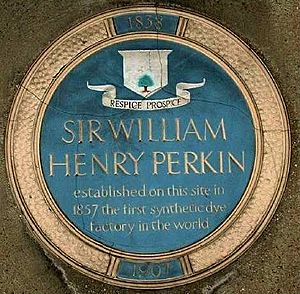
Perkin received many awards during his life. In 1866, he became a Fellow of the Royal Society, a very important scientific group. He received their Royal Medal in 1879 and their Davy Medal in 1889.
In 1906, he was made a knight, so he became "Sir William Henry Perkin." In the same year, he received the first Perkin Medal. This medal was created to celebrate 50 years since he discovered mauveine. Today, the Perkin Medal is considered the highest award in industrial chemistry in the U.S.
William Perkin High School
In 2013, the William Perkin Church of England High School opened in Greenford, Middlesex. The school is named after William Perkin. Its school uniform and colors are mauve, as a tribute to his famous discovery of mauveine.
Imperial College London
Since 2007, Imperial College London has used purple in its graduation robes. This is to celebrate the important work of William Perkin, who studied there. In 2015, the college president said that "The color purple shows the spirit of effort and discovery, and the willingness to take risks that is part of an Imperial education."
See also
 In Spanish: William Perkin para niños
In Spanish: William Perkin para niños



